Aspects of process development for virus vector production to improve quality and quantity
Pharmaceutical Technology Europe
The use of viral vectors as gene delivery and vaccine vehicles has developed rapidly during the last two decades owing to several viral properties. Viruses can infect cells efficiently, often have a broad tissue tropism and can achieve very high levels of either stable or transient transgene expression. Furthermore, their intrinsic immune-stimulatory properties can have adjuvant effects during the treatment of cancer or infectious disease and, importantly for manufacturing scale-up, some viruses can be grown to very high titre (.1012 particles/mL). The development of robust production procedures is essential to move therapeutics that utilize viral vectors into clinical trials, and to make them cost effective for market supply. Here, we describe some of the aspects of production that must be considered and optimized when producing virus vectors on an intermediate or large scale. By drawing examples from our experience of vector production, we show that upstream and downstream processes must be designed..
Viral vectors have increasingly become the delivery mechanism of choice for gene-based therapeutics because of their superior efficiency/toxicity profile. Adenoviral and retroviral vectors are the most commonly used; approximately 1000 trials have been performed worldwide and about half of these make use of these two vector types.1 Developing optimized large-scale production, harvest and purification strategies is vital if regulatory requirements regarding the purity and traceability of the product and the quality control of equipment and facilities are to be met, and to move these innovative medicines through clinical evaluation to market approval.2,3 Downstream and upstream processes need to optimize the quality (mainly purity and biological activity) and quantity of the virus produced, and also be designed to minimize production costs.4,5
Virus preparation methods on a small scale regularly include procedures that are difficult to scale-up, are time and labour consuming, and can cause residual contamination problems (for collection of protocols regarding adenoviral vector generation see reference6 ). In this article, we will discuss methods that can circumvent these issues. In addition, for viruses that are to be used as gene delivery systems, the ratio of total virus particles to infectious virus particles (P:I ratio) needs to be considered and minimized, as this determines the therapeutic window between beneficial effect and toxicity and, therefore, the dose of product that can be delivered to a patient. Figure 1 provides an overview of upstream and downstream factors that together determine the quality and quantity of the virus production process.
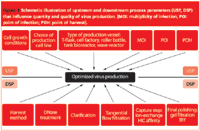
Figure 1
Upstream production strategies
The upstream production process for generating viral vectors involves infecting cells with a virus, culturing the cells to allow the virus to replicate and then harvesting the virus from the cells. Each of these stages must be carefully considered when designing a cGMP production process to ensure that the maximum yields and quality of viral vector are generated.
Infection. The ratio of the number of infectious agents, in this case virus particles, to the number of targets (i.e., cells) is known as the multiplicity of infection or MOI. As master and working virus seed stocks (MVSS and WVSS) are costly, cGMP manufacturing processes should use the lowest MOI that can still produce maximum virus yield. There are no standard MOIs for any combination of cell and virus so these must be determined at the optimization stage for each new process.
The minimum MOI that can be used for successful virus production will depend on the starting material. If crude lysate of a virus is used or the virus has a high P:I ratio, a relatively low MOI (>1.0) is usually more appropriate as, at higher ratios, toxicity resulting from noninfectious particles and excess cellular viral toxic proteins can decrease virus production (data not shown). Cell toxicity is less of a problem if purified virus material is used and/or the virus has got a low intrinsic P:I ratio, meaning that a higher MOI can be chosen (data not shown). Toxicity is further minimized if the purification process achieves the separation of infectious and noninfectious virus particles.
For the production of a lytic human adenoviral vector carrying a nontoxic transgene, the MOI is typically 1–20 infectious units per cell.4 Lower MOIs often result in slow and inefficient virus production. Other viruses can establish effective virus amplification using very low MOIs (e.g., 0.01–0.1).
The optimal MOI for virus production is also linked to the time after infection that is best for virus harvest.7–9 Some viruses (e.g., replicating Reovirus and HSV) will successfully replicate during a prolonged period, starting from low MOI (data not shown); other viruses, such as human adenovirus-based vectors, show optimal virus production if infection time is kept to 48–72 h.4,5
Cell proliferation tends to decline after virus infection. The rate of this slow-down mainly depends on the MOI used, as the metabolic burden on the cells increases with the relative amount of virus present.8 The density of the cell culture once cells are infected with virus particles, the point of infection (POI), must be carefully calculated to enable optimum virus production. To calculate the optimum POI, it is essential to draw a growth curve that shows the maximum cell density before viability decreases significantly. As rule of thumb, the POI is about 50% of the maximum possible cell density as this allows a window for additional cell growth. For most suspension cultures grown in batch-mode, cell density is around 1.0–1.5×106 viable cells/mL.
Culture systems. Cell lines can behave differently when scaled up from laboratory to large culture systems. Therefore, scale-up requires process optimization and process development to transfer virus production processes to the clean room.
For cGMP manufacture, a suspension culture system is often the favoured option because the scale-up issues are much simpler, but there are several viruses including adeno-associated virus (AAV) and Lentivirus that are commonly produced in adherent cell lines. Of the two main systems for adherent cultures, the most commonly used is the cell factory (CF) (Nunc or Corning), which relies on flat surfaces in the form of multilayers. At commercial-scale, the CF can be purchased in a 40-layer format that requires specialized robotic systems to inoculate, feed and harvest cells. The alternative system uses microcarriers maintained in suspension. These can be divided into two major classes; nonporous carriers allow cells to grow only on their surface, while macroporous carriers contain channels that cells can grow inside.10
For large-scale suspension cell culture, the most commonly used system is the stirred tank bioreactor. This system allows the fine-tuning of growth parameters such as dissolved oxygen, pH, temperature and timing of media replenishment for optimal cell growth and increased productivity.
Manufacture of lytic viruses is typically performed in a batch mode where cells are grown and infected in a closed system without replenishment of the media. However, if virus manufacture occurs during a more extended duration or if cell densities increase beyond the level normally supported by the growth media, the media must be replenished using either a fed-batch system (glucose and amino acid feed) or a perfusion system (complete media change).
Harvesting. The standard method for lysing cells within the manufacturing environment has been multiple rounds of freeze/thaw using liquid Nitrogen (-196 °C) and a water-bath set at +37 °C. However, there are several issues that make this method problematic for harvesting, especially within a clean room. As the freeze-thaw process requires a number of open manipulations, maintaining containment of the virus may not be feasible at large-scale production. Aerosol formation can occur if standard polypropylene tubes are used, as positive pressure is generated when the liquid freezes and expands. Upon thawing, a negative pressure can be generated, potentially introducing contaminants to the sample. Furthermore, the process is both time and labour intensive. Alternative methods for virus release are being investigated to solve these issues.
One option is using a Microfluidizer HC5000 CE (MFIC Corporation; Newton, MA, USA), which uses high pressure and a 'Z' chamber to induce shear into the fluid path and break open cells.11 Several different pressures (data not shown) and numbers of passes were tested (Figure 2a) and the results show that this alternative method generally leads to better recovery of viral particles than the standard freeze/thaw cycles. Production of 1.6 L batches of clinical grade virus by freeze/thaw cycles takes approximately 6 h, but only 2 h using a microfluidizer. As the equipment is fully autoclavable and fits easily into a microbiological safety cabinet, product sterility and operator safety can be maintained. The main disadvantage of the microfluidizer revolves around cleaning validation. If the equipment was required for the manufacture of a new viral product, it would be difficult to adequately remove any existing residue to a level below the detection limit of a typical quantitative polymerase chain reaction (PCR) assay.

Figure 2
This issue with quality assurance has led us to investigate whether chemical lysis using a variety of detergents could replace mechanical lysis. In general, we found higher virus recovery using chemical lysis when compared with mechanical lysis. Following treatment with 1% Triton X-100 for 1 h at +37 °C to harvest two viral products, we used an in-house HPLC assay to test for residual detergent in the final preparations. Analyses showed that the amount of residual Triton in the product was below the limit of detection (<2 ppm). In a more detailed investigation, we determined the minimum concentration of detergent needed to achieve cell lysis while maintaining high virus recovery. HPLC data shown in Figure 2b indicate that Triton-X-100 lysed cells efficiently across a 1.0–0.1% (v/v) range, though lysis with Tween-80 at ;0.7–1% is a valuable alternative to using Triton, particularly as it has been used as a formulation excipient for many years.
The length of time after infection that the virus is collected, the point of harvest (POH), must be carefully determined to ensure that the highest quality and quantity of infectious virus particles can be obtained. This time point will depend on several factors: production cell line; virus; length of viral replication cycle; virus half-life; and the MOI and POI used.7–9 Another consideration is that the P:I ratio can sometimes increase if virus production is kept going for too long (data not shown). This results in low-quality virus batches and potentially lowers the therapeutic effects of the product. The POH will also be influenced by the virus harvest strategy. If the virus is to be harvested from viable cells, those viruses that lyse the cell line near to the end of their production cycle (e.g., adenoviruses) must be harvested before this occurs to avoid loss of product into the medium. If the virus is to be harvested by chemical lysis, microfluizider or hypotonic shock into the culture medium, the POH window is wider. In most cases, the POH falls between 48 and 80 h. Patent application US 6,989,264 demonstrates how culture and stress conditions influence distribution of recombinant AAV vectors between secreted and cellular compartments at different time point post-infection.11
Figure 3 shows data from a typical study to assess MOI and POH. Adenovirus producer cells were infected with a MOI of 0.1, 1.0 and 5.0 and virus was harvested after 2, 3 and 4 days by chemical lysis (1% Triton X-100). Infectious titres were then determined by standard plaque assay. The highest titre values were achieved with either MOI=0.1 and POH=4 days or MOI=1.0 and POH=3 days. The yield increase from Day 2 to Day 4 was significantly higher for the low MOI (0.1:16.4-fold) than for the two higher MOIs (1.0:2.3-fold and 5.0:8.25-fold).

Figure 3
Downstream purification solutions
Once the virus has been grown and harvested, the feedstock needs to undergo downstream purification. Several methods used on the laboratory-scale, for example standard high-speed ultracentrifugation for increasing virus concentration, cannot be used for large-scale manufacture, meaning alternative approaches must be identified.
Tangential flow filtration (TFF), or cross-flow filtration, is a well-established separation technique used to concentrate and purify viral products on a large scale.12 In TFF, fluid is pumped tangentially across the surface of a membrane. Particles or molecules that are larger than the molecular weight cut-off of the membrane do not pass through and are returned to the process tank. The process is repeated until sufficient low molecular weight contaminants have been removed and the virus is sufficiently concentrated. Buffer can also be exchanged during this step, improving the stability of the viral product through the addition of appropriate excipients such as sucrose, sodium chloride, ethanol, EDTA, MgCl2 and polysorbate-80.13 Typically, DNA-digest using Benzonase is performed before TFF to reduce the level of contamination of final drug product with host DNA.
Disposable TFF assemblies are now available that offer flexible, self-contained solutions, reducing the requirements for cleaning validation and the risk of cross-contamination associated with traditional stainless steel membrane holders.14 Care should be taken when determining the maximum theoretical concentration of the virus suspension and the optimum volumetric concentration factor (VCF) as viral particles tend to aggregate at high concentrations. Careful monitoring of recovery is required. We found that, after optimization, an essentially complete recovery could be obtained when a 300 KDa MWCO hollow fibre membrane was used to concentrate (VCF=2) and diafilter (6 volumes) a recombinant adenovirus. While the TFF step can be omitted from the downstream purification, the advantage of maintaining a consistent feedstock for the subsequent chromatographic steps cannot be emphasized enough.
The initial ion exchange chromatography step aims to actively capture the target molecule and allow any high molecular weight contaminants to either flow through the column or bind to the resin. The proportion of contaminants that bind can be adjusted by varying the conductivity at which the feedstock is loaded (data not shown).
To elute the virus, contract manufacturers tend towards step elution using buffers that have been prepared at the correct conductivity. This technique simplifies the chromatography step and removes the need for extensive validation of complex gradient mixers, but sacrifices some of the resolution. Broader peaks result with more peak trailing, which can have a detrimental effect on the step yield because the peak will need to be cut before all the product has eluted to reduce the level of dilution (Figure 4a).
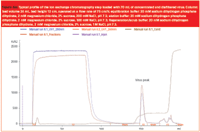
Figure 4(a)
Of particular importance for virus purification is the maximum, working binding capacity for the resin. A breakthrough curve should be drawn for each virus/resin combination while mimicking the actual working conditions.
The final size exclusion chromatography step is designed to remove the few remaining contaminating components. It can also be used to exchange the buffer used in previous steps with the final formulation buffer. Batch separation is an ideal approach for large biomolecules. The target product is totally excluded from the size exclusion resin and separated from any lower molecular weight contaminants. Particular success can be achieved by replacing sephacryl-based resins with sepharose-based resins, which can be loaded in batch separation mode with up to 30% of the total column volume (Figure 4b).
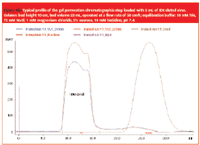
Figure 4(b)
In summary, our typical total recovery of adenovirus using this process is approximately 40% (data not shown).
The final step in any production process is to receive quality control (QC) release. Figure 4c shows some of the typical assays that are performed during clearance of a cGMP viral product.
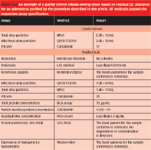
Figure 4(c)
Final thoughts
In this article we have described many aspects of production that must be considered in the design of large-scale virus production processes. The infection time and dose, the cell culture techniques and the time of virus harvest all need to be optimized in conjunction with downstream purification strategies to produce a viral vector that meets with GMP requirements and can, therefore, be used in clinical trials.
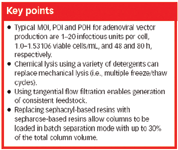
Key points
Matthew Reece-Ford is senior scientist of virology process science, Cobra, which he joined in 1998. During the past 9 years he has been at the forefront of developing the adenoviral production processes for customers. Matthew has worked on a significant number of clinical GMP batches using disposable roller bottle technology and purification by CsCl centrifugation.
Anthony G. Hitchcock is deputy director of process science at Cobra. Tony has more than 19 years' experience in the large-scale manufacture of biopharmaceuticals. Tony was a founding staff member of Cobra and has been responsible for developing much of the company's DNA manufacturing technology.
Kai S. Lipinski is principal scientist of virology process science at Cobra. Kai has more than 10 years of experience in molecular biology, molecular virology and viral vector biology with particular expertise working with adenoviruses, AAV, HSV and retro-/lentiviruses.
References
1. "Gene Therapy Clinical Trials, Charts and Tables, Vectors" (2007). www.wiley.co.uk/genetherapy/clinical
2. E. Burova and E. Ioffe, Gene Ther., 12(Suppl 1), 5–17 (2005).
3. R. Morenweiser, Gene Ther., 12(Suppl 1), 103–110 (2005).
4. I. Nadeau and A. Kamen, Biotechnol. Adv., 20(7–8), 475–489 (2003).
5. A. Kamen and O. Henry, J. Gene Med., 6(Suppl 1), 184–192 (2004).
6. J. Luo et al., Nat. Protoc., 2(5), 1236–1247 (2007).
7. V. Cortin, et al., Biotechnol. Prog., 20(3), 858–863 (2004).
8. L. Maranga, J.G. Aunins and W. Zhou, Biotechnol. Bioeng., 90(5), 645–655 (2005).
9. T.B. Ferreira et al., J. Biotechnol., 119(3), 272–280 (2005).
10. Microcarrier cell culture. Principles and Methods. GE Healthcare Cat. No. 18-1140-62 (2005).
11. E.M. Atkinson et al., Patent No. US 6,989,264 (2006).
12. N.E. Altaras et al., Adv. Biochem. Eng. Biotechnol., 99, 193–260 (2005).
13. R.K. Evans et al., J. Pharm. Sci., 93(10), 2458–2475 (2004).
14. R.L. Stedman, E. Kravitz and H. Bell, Appl. Microbiol., 2(3), 119–124 (1954).
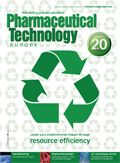
Drug Solutions Podcast: Applying Appropriate Analytics to Drug Development
March 26th 2024In this episode of the Drug Solutions Podcast, Jan Bekker, Vice President of Business Development, Commercial and Technical Operations at BioCina, discusses the latest analytical tools and their applications in the drug development market.